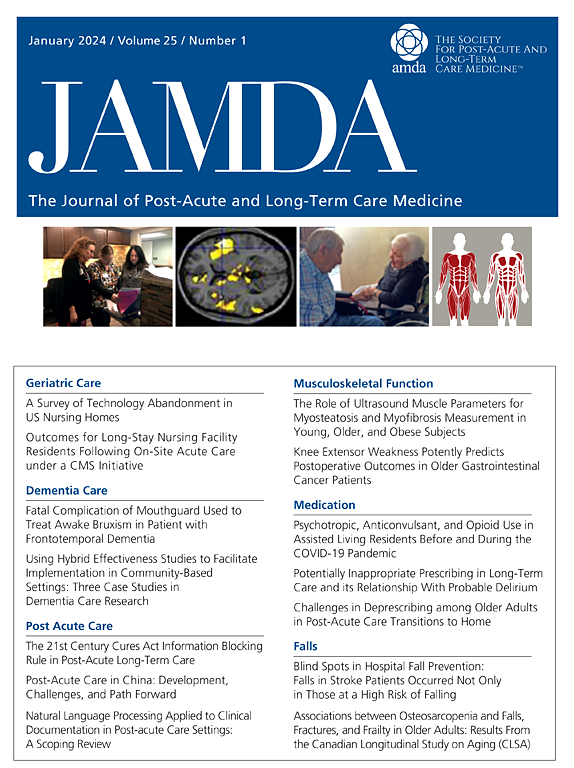Impact of Quality Improvement Interventions on Hospital Admissions from Nursing Homes: A Systematic Review and Meta-Analysis
IF 4.2
2区 医学
Q2 GERIATRICS & GERONTOLOGY
Journal of the American Medical Directors Association
Pub Date : 2024-09-27
DOI:10.1016/j.jamda.2024.105261
引用次数: 0
Abstract
Objective
To synthesize evidence assessing the effectiveness of quality improvement (QI) interventions in reducing hospital service use from nursing homes (NHs).
Design
Systematic review and meta-analysis of randomized controlled trials (RCTs), controlled before-after (CBA), uncontrolled before-after (UBA), and interrupted time series studies. Searches were conducted in MEDLINE, CINAHL, The Cochrane Library, Embase, and Web of Science from 2000 to August 2023 (PROSPERO: CRD42022364195).
Setting and Participants
Long-stay NH residents (>30 days).
Methods
Included QI interventions using a continuous and data-driven approach to assess solutions aimed at reducing hospital service use. Risk of bias was assessed using JBI tools. Delivery arrangements and implementation strategies were categorized through EPOC taxonomy.
Results
Screening of 14,076 records led to the inclusion of 22 studies describing 29 QI interventions from 6 countries across 964 NHs. Ten studies, comprising 4 of 5 RCTs, 3 of 4 CBAs, and 1 of 12 UBAs were deemed to have a low risk of bias. All but 3 QI interventions used multiple component delivery arrangements (median 6; IQR 3-8), focusing on the “coordination of care and management of care processes” alone or combined with “changes in how, when, where, and by whom health care is delivered.” The most frequently used implementation strategies were educational meetings (n = 25) and materials (n = 20). The meta-analysis of 11 studies showed a significant reduction in “all-cause hospital admissions” for QI interventions compared with standard care (rate ratio, 0.60; 95% CI, 0.41-0.87; I2 = 99.3%), with heterogeneity due to study design, QI intervention duration, type of delivery arrangements, and number of implementation strategies. No significant effects were found for emergency department (ED) visits or potentially avoidable hospitalizations.
Conclusions and Implications
The study provides preliminary evidence supporting the implementation of QI interventions seeking to reduce hospital admissions from NHs. However, these findings require confirmation through future experimental research.
质量改进干预措施对养老院入院率的影响:系统回顾与元分析》。
摘要综合评估质量改进(QI)干预措施在减少疗养院使用医院服务方面的有效性:设计:对随机对照试验(RCT)、前后对照试验(CBA)、前后非对照试验(UBA)和间断时间序列研究进行系统回顾和荟萃分析。搜索范围包括 2000 年至 2023 年 8 月期间的 MEDLINE、CINAHL、The Cochrane Library、Embase 和 Web of Science(PROSPERO:CRD42022364195):长期住院的 NH 居民(超过 30 天):纳入的 QI 干预采用持续和数据驱动的方法,以评估旨在减少医院服务使用的解决方案。使用 JBI 工具评估偏倚风险。通过 EPOC 分类法对实施安排和实施策略进行分类:通过对 14,076 份记录的筛选,共纳入了 22 项研究,这些研究描述了来自 6 个国家、964 家 NHs 的 29 项 QI 干预措施。10项研究(包括5项RCT中的4项、4项CBA中的3项和12项UBA中的1项)被认为偏倚风险较低。除 3 项 QI 干预措施外,其他所有干预措施都采用了多组分提供安排(中位数 6;IQR 3-8),重点是 "协调护理和管理护理流程",或结合 "改变提供医疗服务的方式、时间、地点和人员"。最常用的实施策略是教育会议(n = 25)和材料(n = 20)。对 11 项研究进行的荟萃分析表明,与标准护理相比,QI 干预能显著降低 "全因入院率"(比率比为 0.60;95% CI 为 0.41-0.87;I2 = 99.3%),但由于研究设计、QI 干预持续时间、提供安排类型和实施策略数量的不同,存在异质性。在急诊室就诊或可能避免的住院治疗方面未发现明显效果:本研究提供了初步证据,支持实施 QI 干预措施,以减少来自 NHs 的住院人次。然而,这些发现还需要通过未来的实验研究加以证实。
本文章由计算机程序翻译,如有差异,请以英文原文为准。
求助全文
约1分钟内获得全文
求助全文
来源期刊
CiteScore
11.10
自引率
6.60%
发文量
472
审稿时长
44 days
期刊介绍:
JAMDA, the official journal of AMDA - The Society for Post-Acute and Long-Term Care Medicine, is a leading peer-reviewed publication that offers practical information and research geared towards healthcare professionals in the post-acute and long-term care fields. It is also a valuable resource for policy-makers, organizational leaders, educators, and advocates.
The journal provides essential information for various healthcare professionals such as medical directors, attending physicians, nurses, consultant pharmacists, geriatric psychiatrists, nurse practitioners, physician assistants, physical and occupational therapists, social workers, and others involved in providing, overseeing, and promoting quality

 求助内容:
求助内容: 应助结果提醒方式:
应助结果提醒方式:


